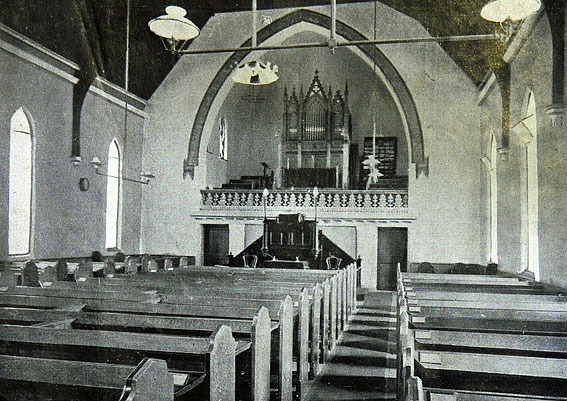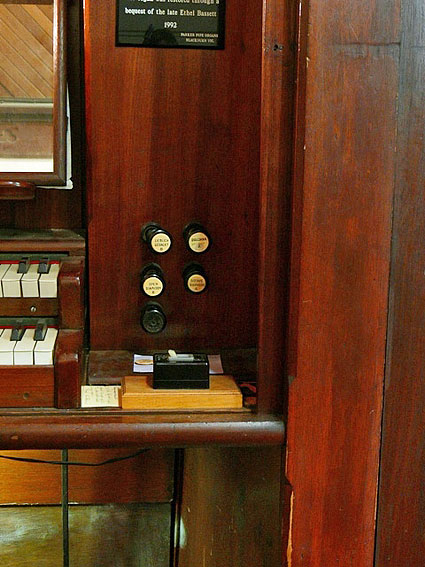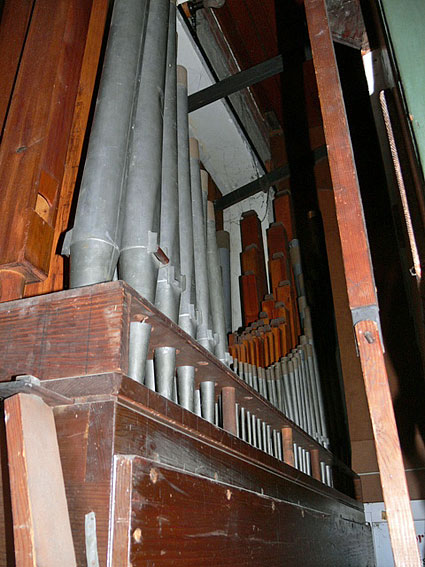St Paul's Anglican Church
Station Street, Fairfield
First organ, B c.1857 Jesse Biggs;
inst St Andrew's Anglican Church, Brighton.
Inst 1860 Wesley Church, Lydiard Street, Ballarat;
inst 1874 Methodist Church, Pleasant Street, Ballarat;
inst 1921 St Mark's Anglican Church, Camberwell;
inst c1928 Fairfield; rem c1968; parts used elsewhere.
1m, 9 sp st, 1c, tr & tub pn. Man: 8 divided.8 divided.8.4.4.2-2/3.2.III. Ped: 16.
Present organ, B 1920 J.E. Dodd for St Barnabas' Anglican Church, Montague;
inst 1968; res 1992 John Parker (Great Dulciana 8 transposed to 2).
2m, 11 sp st, 4c, tr & tub pn. Gt: 8.8.4.2. Sw: 8.8.8.4.8. Ped: 16.16.

Historical and Technical Documentation by John Maidment
© OHTA 2012 (November 2008, last updated May 2012)

St Paul's Anglican Church was established in 1885 and the present brick church built in 1916.
The previous organ at Fairfield was built c.1857 by Jesse Biggs, who had arrived in Melbourne the previous year from Gray & Davison, London, where he had trained. He built a few early organs in Victoria at this time, one of which survives at St Luke's Lutheran Church, Cavendish. It was initially installed in the English Church, Brighton (St Andrew's Anglican Church) but was replaced there in 1860 by a Hill & Son organ acquired from the residence of Peter Davis. It was then moved to Wesley Church, Ballarat and is thought to have been the first pipe organ on the Ballarat goldfields. It was moved in 1874 to the Methodist Church, Pleasant Street, Ballarat where a photograph of the instrument survives at the Uniting Church Archives, Elsternwick. From Ballarat it was moved in 1921 to the hall at St Mark's Anglican Church, Camberwell and when the new church and organ there were opened in 1927 it was moved to St Paul's Church, Fairfield around 1928. When inspected in the mid 1960s it was observed that the original casework, action and pipework survived but that the stop action and drawstops had been replaced by stopkeys and tubular-pneumatic action. The instrument was in a parlous state: pipes were leaning inside and at the point of falling over, and the wooden parts had been severely attacked by borer. J.A.H. Brooks, who helped to install the Dodd organ, was given the parts of the previous organ. At Fairfield, it appears that the stencilling of the façade pipes had been overpainted, and the cusping of the flats removed together with some pinnacles from the casework.

Pleasant Street Methodist Church, Ballarat
MANUAL |
8 8 8 8 8 4 4 2-2/3 2 II-III 16 |
wood CC-BB TC CC-BB TC TC TC metal chimney flute |
Compass: 54/30
All enclosed except Open Diapason Bass and Bourdon
The present organ was built in 1920 by the Adelaide organbuilder J.E. Dodd for St Barnabas' Anglican Church, Montague, in Montague Street, South Melbourne. This was a very large brick church with clerestoried nave, but the chancel had never been completed as intended. The church was closed and demolished at the end of the 1960s and the organ moved to Fairfield in 1968.
J.E. Dodd, who had trained in Melbourne with George Fincham, sent the following organs to Victoria:
1916 Congregational Church, Malvern. Later at Caulfield Grammar School and destroyed by fire.
1917 St Joseph's Catholic Church, Malvern. Broken up.
1920 St Barnabas' Anglican Church. Montague. Now at St Paul's Anglican Church, Fairfield.
1920 St Matthew's Presbyterian (now Uniting) Church, Stawell. Rebuilt. Tonally unaltered.
1921 St Andrew's Presbyterian (now Uniting) Church, Colac. Rebuilt with minor tonal alterations.
1921 Methodist Church, Port Melbourne. Removed 1960s and parts in storage.
1921-24 Queen's College Chapel, Parkville. Rebuilt and tonally altered.
1923 Trinity College Chapel, Parkville. Rebuilt and broken up 1998.
1924 Methodist (now Uniting) Church, Coburg. Unaltered.
The following three Dodd organs arrived in Victoria later:
1898 Methodist (now Uniting) Church, Benalla. Installed 1930. Built for Primitive Methodist Church, North Adelaide. Rebuilt.
1906 Knox Presbyterian Church, Ivanhoe. Installed 1939. Built for residence of C.H. Fisher, Medindie, SA. Parts now at Aitken College, Greenvale. Casework removed.
1921 Christ Church Cathedral, Ballarat. Installed 2004. Built for Methodist Church, Wallaroo Mines, SA. Rebuilt and enlarged.
Of these instruments, only the instruments now at the Uniting Church, Coburg and St Paul's Anglican Church, Fairfield remain largely intact. The Coburg organ, built with tubular-pneumatic action, requires serious restoration but the Fairfield organ is in a playable state having received a renovation in 1992 by the Melbourne organbuilder John Parker. It was among the last instruments installed in Victoria with a mechanical key action before the orgelbewegung revival of the 1970s.
GREAT |
8 8 8 4 8 8 8 4 8 16 16 |
(transposed to 2 1992) (by pedal) (derived from Bourdon at half wind) |
Compass: 58/30
Mechanical key action to manuals
Tubular-pneumatic pedal, stop action and façade pipes
Balanced swell pedal
3 composition pedals to Great
2 composition pedals to Swell
Balanced swell pedal

|
||
 |
 |
|

|
||
 |
 |
|

|
||
Photos: JRM (Nov. 2008)
History of the Methodist Church, Pleasant Street, Ballarat (Uniting Church Archives, Elsternwick)
Matthews, E.N. Colonial Organs and Organbuilders. Carlton: Melbourne University Press, 1969, p.159
Hookey, Margaret. St Mark's Camberwell: the First Seventy-Five years. Camberwell: The Vestry of St Mark's Church, 1988, p.13